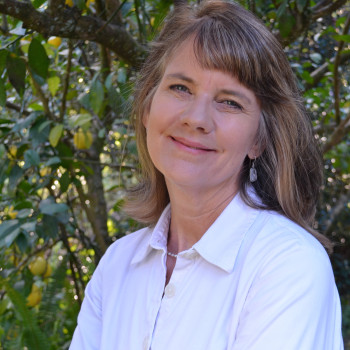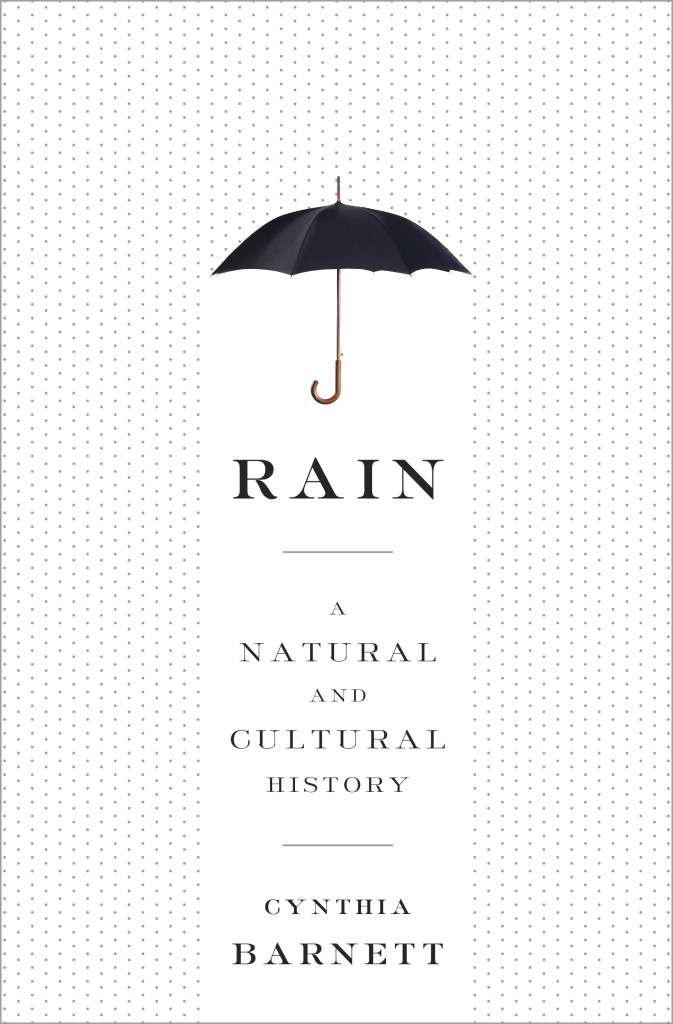Chattering Class is the part of the show where we get schooled in a dinner party worthy topic. This week, the subject is rain and our expert is award-winning environmental journalist Cynthia Barnett. She has written two previous books about water, and her latest book, fittingly, is about rain. It is called “Rain: A Natural and Cultural History.”
 Brendan Francis Newnam: Let’s just begin at the beginning. This book is humongous. I’m not going to be able to talk about everything in it, obviously, but let’s just start with the basics. What is rain?
Brendan Francis Newnam: Let’s just begin at the beginning. This book is humongous. I’m not going to be able to talk about everything in it, obviously, but let’s just start with the basics. What is rain?
Cynthia Barnett: I can tell you that in a drop of rain is the water we know about, but then there also has to be something else. There has to be a little tiny something for the drop to cling to. So, there’s a tiny bit of dust or even a tiny bit of bacteria. Anything that’s called condensation nuclei, allows the drop to actually cling around. That’s what it needs to form a drop.
Brendan Francis Newnam: Does that mean there’s no such thing as clean rain because it’s all clinging to something?
Cynthia Barnett: You know, I hate to tell you this, but there’s no such thing as clean rain.
Brendan Francis Newnam: Oh, man.
Cynthia Barnett: I know! I know, it dashes – there’s no clean snow, either really. When you think about it, it falls through the sky that we’ve pumped full of all kinds of emissions. It travels around the world through anything we’ve put out into the world. So, for me, that was sort of the really interesting lesson of this book.
Brendan Francis Newnam: So, getting rained on is basically like taking a dirty shower.
Cynthia Barnett: I don’t know if I’d say that. Even with everything I’ve learned about rain and what’s in rain, I love being out in the rain. I just danced with my kids in the rain yesterday.
Brendan Francis Newnam: Well, dirty or not, man has an interesting relationship with rain. Man has often tried to control rain. Your book is filled with many colorful stories about people trying to master rain in one way or another. One of them that stands out is James Pollard Espy, who was, I believe, America’s first meteorologist?
Cynthia Barnett:Â So, the interesting thing about James Pollard Espy is that he was a brilliant meteorologist, and he was the United States’s first meteorologist.
Brendan Francis Newnam: Under Ulysses S. Grant, right, the president?
Cynthia Barnett: Yes, and the one falter he had in his atmospheric brilliance is that he believed that fire caused rain, which makes sense, you know, remember what I said about you needing some little tiny particle. So, he thought that if we sent particles up into the atmosphere that it would make it rain.
He actually proposed to Congress that we plant vast forests throughout the middle of the nation and light them afire when drought came so that we could make it rain, and that never happened. And the interesting thing about why it didn’t happen — it’s not that people didn’t believe that we could do it. It was that, actually, the southern congressmen were really worried about the federal government, as they still are, right? So, they didn’t want the government to be able to control the weather, and that’s why his proposal didn’t pass.
Brendan Francis Newnam: Oh, interesting. So, they weren’t suspicious of Espy’s idea that if you burned large swaths of forest, rain would come.
Cynthia Barnett: No, no. People had very crazy ideas about how to make it rain.
Brendan Francis Newnam: Well, people can turn to your book if they want to hear more of those stories because now we’re going to play a game I created. There’s so many neat facts in this book. I was trying to think of a way to get to them. So, I created this game. It’s called the “Rain Fact Lightning Round.” Get the pun?
Cynthia Barnett: I love it!
Brendan Francis Newnam:Â Thanks. So, I’m going to read you some facts I learned in your book, and you can maybe just give me a short explanation.
Cynthia Barnett: Let’s do it. I’m ready.
Brendan Francis Newnam: All right. So, the first one is the expression, “When it rains, it pours.”
Cynthia Barnett: Okay,
“When it rains, it pours,” comes from an ad developed for Morton Salt Company.So, you know the wonderful girl with the umbrella on the cylinder of Morton Salt? In the early 20th century, table salt had this notorious problem of caking up in rainy weather, and nobody could get their salt out of the canister.So, Morton began adding something — it was an anti-caking agent called magnesium carbonate — to its salt so that it would pour better, but the executives didn’t want to say, “Oh yay, we have added magnesium carbonate.” So, some brilliant marketing person came up with, “When it rains, it pours,” so that they could emphasize the benefit that Morton Salt could pour in any weather.
Brendan Francis Newnam: It’s actually a really elegant tagline, and now it just reads like cynicism. You know, it’s just like, “Well, of course! When it rains, it pours.” But in reality, it’s like, no, when it rains, the salt will pour because it will not cake.
This one’s a little more obscure in the Lightning Round, but you’ll know what I’m getting at and you can explain it to us: pruned fingers.
Cynthia Barnett: Yeah. So, finger wrinkles — we evolved in what scientists call “pluvial times,” a time of a lot of rainfall in East Africa. So, many million years ago, when we began walking upright, the rainforest was turning to desert and we stand up and begin to search for rain.
AÂ neurobiologist I interviewed named Mark Changizi has linked the finger wrinkles on our hands to those times. He hypothesized that we needed grips. They’re essentially rain treads for helping us get along in those jungles in super-rainy times, and we don’t need them when it’s not raining. Our fingers are smooth because it’s better to grip with smooth fingers in dry times, but in wet times, our fingers actually do a much better job of gripping when we have those finger wrinkles.
Brendan Francis Newnam: Like tires for your car.
Cynthia Barnett: Right, exactly.
Brendan Francis Newnam: All right. And so, my last question: what is your favorite song about rain?
Cynthia Barnett: That’s a really hard one. I’m going to have to say, and this is odd because I love rain, but “I Can’t Stand the Rain” by Ann Peebles.*
Brendan Francis Newnam: All right. Cynthia, thank you for braving the rain in Florida to come speak with us.
Cynthia Barnett: Thank you so much for having me on. It’s been really fun.
*Ed note: Cynthia shared her YouTube playlist of songs about rain. Check it out below!

IT’S A PARTY IN YOUR INBOX…
…when you subscribe to our weekly newsletter. You’ll find all sorts of good stuff there like bonus audio, musings on culture from our staff, photos of our guests and co-hosts being ridiculous, and new cocktail recipes. Sign up below!



